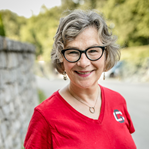“You have to take a library science class about collaboration to get your teaching license.” Confounded. Confused. Downright dumbfounded. That was me.
I had been a librarian for about 20 years and was working on my teaching degree; the last thing I wanted to do was take a library science class. However, as I tell my students, grace and grit will get you further than smarts and slack. So, off I went.
Voila. It was one of the best learning experiences of my career. Most of my classmates were 20-somethings who were teaching, wanted to be librarians (I mean….who doesn’t?), and had great disdain for “older” librarians who didn’t know how to collaborate. When the “I’ll show them” fight response rose up, I quelled it and got to work. As a librarian, I was positioned to flourish as a collaborator and leader.
How do we collaborate well? Let’s face it: collaboration gets messy and doing everything yourself is often much simpler. Effective communication requires synergy and idea-sharing. Let’s look at some practical ways to collaborate and discuss a few ways to overcome time constraints.
Use all the moments
Lunch? It’s a great time to ask what a teacher did in class that day. Recess? It’s a chance to chat about what challenges a teacher has. Those moments reap two rewards.
First, people are incentivized to collaborate with people they know, trust and admire. Building relationships fosters teamwork and energy.
Secondly, those short lunch conversations turn into larger conversations, the result of which is more collaboration and increased questions. Where do we struggle? What are our successes in the classroom? We formed professional learning communities that would meet at lunch to teach one another about assessments, instructional methods and technology integration. While I can “teach” these topics, teachers collaborating with me reaps a harvest of discussion, ideas and action.
Set clear expectations and deadlines
Have you ever thought as you were leaving a meeting, What are we doing? Writing down exactly what is expected and what the deadlines are avoids frustration on both sides. Statements such as, “Change Biblical integration from just Bible verse citations to real language for all English classes by September 21, 2021,” serve to concentrate the minds of teachers and to remind the administrator to check in on progress before the deadline.
Train, train, train
The plethora of apps to learn, grades to enter, and forms to complete can overwhelm a teacher. Training them once and expecting them to savor and digest both the theory and the practice is unrealistic. We have training sessions as a whole faculty twice a year, and I have faculty do one curriculum mapping task at every faculty meeting. One-on-one meetings help teachers overcome their fears and give people a chance to chart a course forward without comparing their progress with others. One-on-one bursts the “everyone else knows this but me” balloon and releases them to ask necessary questions.
Encourage
Teachers work autonomously most of the time. They get it done. On their own steam. No one drifts into collaboration and communication: we need to be discipled and trained to share, and we need to be tutored in how to ask questions. To facilitate asking questions and sharing information, lunch works! Just like kids, teachers want to share a table with friends. Our school provided the lunch and the teachers provided the questions about a given topic and the support for ideas about assessment, classroom management and that thorny instructional juggernaut.
Teachers are goldmines of enthusiasm, ideas and love for kids. Plumbing the depths of those mines can be challenging, but treasures are there for the taking.




